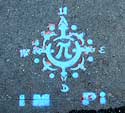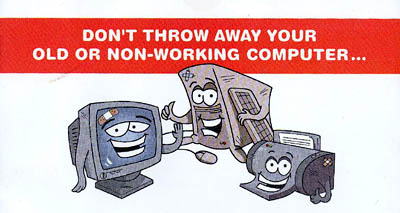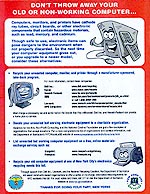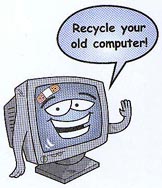e-waste
Updates
Recent happenings on old blog posts:
|
More Public Schools: In March 2009, I wrote about The Public School a website where people propose, discuss, and coordinate free, offline classes taught by volunteers. The project has since expanded from Los Angeles to 6 more cities including New York, Paris, and San Juan. And still more coming soon! I taught a class on Mapping as Activism last month and had a great time. |

|
|
Listener Supported: In December 2008, I wrote about Spot.us, a site for crowd-funded news where anyone can pitch and help pay a journalist to produce a local story. Last week, Public Radio Exchange announced they will pick up the software to launch StoryMarket to bring the model to public radio. |

|
|
Guerilla Wayfinding in NYC: In March 2006, I proposed a compass rose stencil at the exits of New York City subway stations. Shortly after, stencils started appearing! A year later, City officials decided to implement a few test marks of their own, and I found out the idea had been proposed back in 1992. Now it’s 2010 and new compass stencils have popped up at downtown subway exits. |

|
|
The Trouble with Hippos: In February 2006, I wrote about the Hippo Water Roller, a rugged, round water container designed to be transport water on tough rural roads. Last year, Alissa Walker reported on some of the obstacles the project encountered with extended use, and when trying to scale up production. |

|
|
Public Designer: My first article for Communication Arts ran in February 2005 on citizens designing for better government. It included several examples orchestrated by Sylvia Harris. This month the AIGA published a great interview with her that’s worth checking out. Harris is a public designer if ever there was. |

|
|
Get the E out of NYC: In 2004, I wrote about New York City’s trial collection of electronic waste for recycling. On May 29, 2010, New York State decided it’s illegal to throw away your electronic waste in the regular trash. Governor Patterson just signed a producer responsibility law requiring manufacturers to pay for collection and recycling of e-waste from consumers (including individuals, schools, municipalities, small businesses and non-profits.) |

|
Quickies
Danish anti-war posters hit Iraq:
“On Friday, Iraqis started hanging over 1000 posters created by the artists in the most populous and important quarters of the capital, including the diplomatic Green Zone in the very heart of the city. Artist Claus Rohland, 50, explained to Aljazeera.net why he and fellow artist Jan Egesborg, 40, had got involved and what message they hoped to send to ordinary Iraqis.... ‘We as Danes are part of this so-called coalition and are taking part in this war. But Denmark is a very small country that has not been at war for many years. We need to question what we are doing and what is happening,’ Rohland said. ‘None of the warring parties — neither US-led forces nor Iraqi rebels — present a solution to this war. The ultimate solution needs to come from ordinary people. It may sound naive, but we would encourage people to keep faith in themselves that a final solution rests with them.’”
---
North Dakota has no plans to alter Sioux logo:
“The NCAA considers the logo and nickname ‘hostile and abusive,’ and has ordered the school to cover up all Fighting Sioux references for the NCAA playoffs. The arena, which operates separately from the school, is holding the West Regional hockey tournament in March. [Jody Hodgson, arena manager,] said there are no plans to alter any logos, which can be found on floors, walls, seats and railings. Eliminating them would be too expensive, he said.”
---
Electronics industry urges federal e-waste action:
“A nine-member panel appearing before the U.S. House of Representatives subcommittee on environment and hazardous materials expressed concern that the current trend of varied state and local laws targeting e-waste management would breed inefficiency, confusion and higher prices for consumers.... The best approach, [Renee St. Denis of Hewlett-Packard] said, is for federal lawmakers to create a system in which the manufacturers themselves set up recycling programs and bear the necessary costs.”
---
Deal for Public Toilets in New York City. Only 20 toilets, but it’s a start. The winning company will rebuild all city newsstands and bus shelters, too — and sell the ad space. Not sure how I feel about a private corporation owning all that public space — but then the NYC gov pays nothing. More on the the long history of trying to build public toilets in NYC here and here.
---
Alcaldía favorece proyecto de biogas. Nicaragua’s biggest garbage dump in the Barrio La Chureca in Managua could be used to create enough electricity to illuminate the nearby municipality of Ciudad Sandino. The joint U.S.-Nicaraguan company Conjuris says they can create four megawatts of electrical energy from the gases emitted by burning the garbage. The company is willing to invest US$5.25 million in the project in return for a twenty year contract.
---
It’s great to see graphic designers come together at displaceddesigner.com, the AIGA, and Design Observer to help other graphic designers affected by Hurricane Katrina. I’m all for community and solidarity. But then it’s really not the professional designers that are hurting the most, no?
---
Only one more month until the October 31 deadline to submit your radical graphics to Reproduce & Revolt. And it looks like Favianna has joined the project!
Silicon in the Naked City

Last week, I was delighted to receive a piece of mail from the New York City Department of Sanitation.
The flyer announced a series of events around the city to collect, refurbish, and recycle old electronics in an environmentally responsible manner.
Electronic devices constitute less than one percent of the NYC waste stream, but the materials are extremely toxic if not disposed of properly.
I know non-profit and volunteer groups hold collection events from time to time, but I almost always find out about them after the fact. The refurbished computers are usually donated or sold to low-income families, schools, and community groups for a nominal fee.
This time, however, the Department of Sanitation itself is sponsoring events in the five boroughs to collect e-waste. Working cell phones are being donated to Collective Good.
The events are jointly funded by Dell and Lexmark and the National Recycling Coalition. The Lower East Side Ecology Center and other community groups are coordinating.
I asked Robert Lange, New York City’s Director of Recycling and Waste Prevention about the events:
SDN: Was this started at the initiative of the City, local groups, or manufacturers?
 Click to view a larger version |
I usually find out these things after the fact. What kind of outreach are you doing?
We sent out the flyer well in advance to every residence in the city, and posted the information on our Web site.
Is this aimed primarily at consumers or businesses or both?
It is aimed at city residences.
Will there be a similar push directed at businesses?
It’s possible.
In things like this, it depends on who picks up the tab. Does the tab get picked up by the businesses that profit from the manufacture and sale of these items? Is the tab picked up by consumers? Is some ways, ultimately, the tab is always picked up by the consumer, either directly associated as a charge with the item when they by it, or indirectly through a tax, to run a municipal program, for example.
In my own estimation, because there is an infrastructure for producing these things and delivering the products to people, it makes sense to use the same distribution network to take them back if possible.
And to some extent, Dell and other manufacturers are doing that. If you look at the flyer or the Web site, there are services currently provided by these companies for taking back computers. In some cases, there’s a nominal charge, in other cases there’s no charge, but it’s services they provide to directly take back computers from consumers after their useful life.
Given the toxicity of materials, is there a chance that the disposal may be regulated legislatively?
There are materials like this in the waste stream that are increasing in volume and they need to be addressed. Whether they need to be addressed by a municipal program or not is something that is still in question.
There are a variety of proposed pieces of legislation, both in our area and in other parts of the country to require that this material be handled in a more responsible manner. Different legislators have different perspectives on who picks up the tab.
My own opinion is that this is something that manufacturers should really be required to deal with. And to some extent they are stepping up to the plate because the funds for these drop-off programs that we are running through community-based organizations are being provided by Dell and Lexmark.
 I don’t know if you are familiar with an organization called RBRC which is for taking back batteries — particularly Nickel Cadmium batteries. It is funded and run by the battery industry. A few years ago, when the industry was facing the potential of severe regulation governing how batteries could be disposed of, all the manufacturers got together set up an informal network to receive batteries from the public. All the Radio Shacks, Staples, and organizations like that take back batteries from the public as part of the network they established. And they did that try to avoid the kind of regulation that was coming down.
I don’t know if you are familiar with an organization called RBRC which is for taking back batteries — particularly Nickel Cadmium batteries. It is funded and run by the battery industry. A few years ago, when the industry was facing the potential of severe regulation governing how batteries could be disposed of, all the manufacturers got together set up an informal network to receive batteries from the public. All the Radio Shacks, Staples, and organizations like that take back batteries from the public as part of the network they established. And they did that try to avoid the kind of regulation that was coming down.
I think the computer industry has an even greater incentive to do that, so I expect that what is now fairly informal will become a more formal network in the future. Either that or there will be legislation passed.
What are your future plans?
This is something of an experiment. As I said, the funds are being provided by Dell and Lexmark. Whether they will continue to provide funding... they have not made a long range commitment to that effect.
The collections will run through the fall. How we go forward will depend on the amount success we have. Events like this have been run in the City before and the average tonnage of computers and electronics received per event is approximately 10 tons. We hope to see exponentially higher numbers because this mailing is going to every household in the City.
For more information, visit the NYC Wasteless Web site.
...
And while we’re talking trash, big up to the Mayor for his plan to ship waste from Manhattan’s 59th Street pier instead of trucking it to Brooklyn and the South Bronx.This should relieve some of the burden from low-income neighborhoods who overwhelming suffer the traffic of the City’s trash.
California Senate Passes E-Waste Bill
On June 4, 2003 the California Senate approved a bill that would require electronics manufacturers to recycle discarded computers and electronics equipment, and to set up and fund a recycling infrastructure. From news.com:
“If the bill is signed into law [by the state assembly and Governor Gray Davis], manufacturing companies by the beginning of 2005 would have to arrange for the recovery of 50 percent of all machines sold during the preceding year. That rate would grow to 70 percent in 2007 and 90 percent in 2010. According to the bill, just 20 percent of obsolete computers and TV sets are currently recovered for recycling. Under the bill, companies could either set up and finance state-approved drop-off programs, under which people could bring their older computers, or the companies could pay the state to do it. They would also have to develop recycling plans....
Governor Davis last year vetoed a bill similar to SB 20, but that earlier bill didn’t allow high-tech companies the option to run such programs themselves, as the new one does.
Although the current bill would affect only those companies doing business in California, the state, which is home to the tech-heavy Silicon Valley, often leads the country in environmental and other trends. Similar bills have been proposed in other states and in the U.S. Congress.”
See the text of Senate bill SB 20.
Other city and county-level initiatives mandating electronics recycling and “take-back” programs are also moving forward throughout California.
The Federal National Computer Recycling Act was introduced in the House on March 6, 2003 by Mike Thompson (Democrat, Napa Valley, California). The bill proposes a fee on all computer and peripheral sales. The fee would fund local programs to collect, reuse, resell, or recycle computer equipment. Gear would be exempt from the fee if its components are likely to be reused or disposed of properly. The bill also mandates a Congressional study on the health and environmental impact of materials used in computers. The bill covers other consumer electronics that “contain a significant amount of material that, when disposed of, would be hazardous waste.”
Eco PC
Lead, beryllium, mercury, cadmium, brominated flame retardants... the toxic chemicals in your PC and CRT monitor pose both occupational and environmental threats, particularly in low-income communities and developing countries. (Compare maps of Santa Clara’s toxic sites with a county map of child-poverty levels.)
The Silicon Valley Toxics Coalition writes:
“Electronic waste from obsolete computers, televisions and other devices is one of the fastest growing and most toxic sources of waste. According to the United States Environmental Protection Agency, in 2000 more than 4.6 million tons of e-waste ended up in US landfills and the amount is projected to grow fourfold in the next few years.”
A news.com series on computer disposal notes, “All parties involved in the recycling debate agree there is only one way to achieve environmental safety in computer disposal: Redesign the hardware from scratch.”
Japanese computer maker NEC has risen to the challenge. The PowerMate Eco is billed as the world’s first “environmentally-friendly” PC. The device features a 900MHz Transmeta Crusoe processor, 256 MB of RAM, a 20GB hard drive, and a built in LCD display. Environmentally-friendly qualities include:
- A lead-free motherboard
- A low-heat design that doesn’t require a noisy fan
- An energy efficient LCD display that doesn’t contain the hazardous materials found in conventional CRT monitors
- A case that’s made from 100% recyclable plastic that doesn’t require the toxic brominated fire-retardant coating of traditional plastic cases
Between the energy efficient processor and LCD display, NEC estimates the device uses one-third the power of other PCs.
For more information, see the PowerMate product page or press release.
Blue Screen of Death
Where do old PC’s go to die? In February 2002, the Basel Action Network the Silicon Valley Toxics Coalition released the report “Exporting Harm: The High-Tech Trashing of Asia” which reveals that “huge quantities of hazardous electronic wastes are being exported to to China, Pakistan and India where they are processed in operations that are extremely harmful to human health and the environment.”
Four villages in Guiyu, Guangdong province (about 4 hours drive from Hong Kong) have been turned into toxic waste dumps.
“About 100,000 poor migrant workers are employed breaking apart and processing obsolete computers imported primarily from North America.... The operations involve men, women and children toiling under primitive conditions, often unaware of the health and environmental hazards involved in operations which include open burning of plastics and wires, riverbank acid works to extract gold, melting and burning of toxic soldered circuit boards and the cracking and dumping of toxic lead laden cathode ray tubes. The investigative team witnessed many tons of the E-waste simply being dumped along rivers, in open fields and irrigation canals in the rice growing area. Already the pollution in Guiyu has become so devastating that well water is no longer drinkable and thus water has to be trucked in from 30 kilometers away for the entire population.”
The United States is the only developed country in the world that has not ratified the Basel Convention, a UN treaty which bans the export of hazardous wastes from the worlds most developed countries to developing countries.
The report features stunning photographs from Jeroen Bouman. You can find some of his photos and audio commentary as part of the BBC’s Disposable Planet? site.
Found via Slashdot

